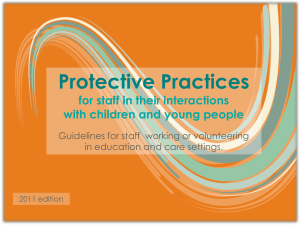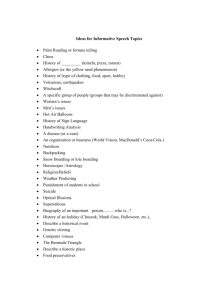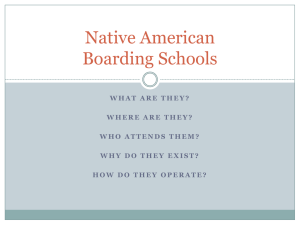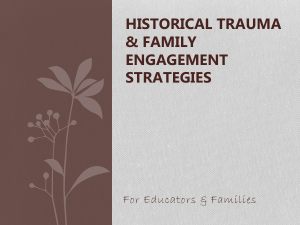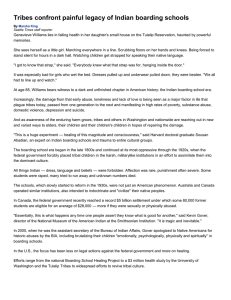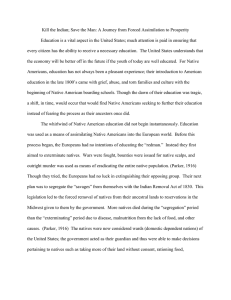Substance Use Disorder_ME.
advertisement
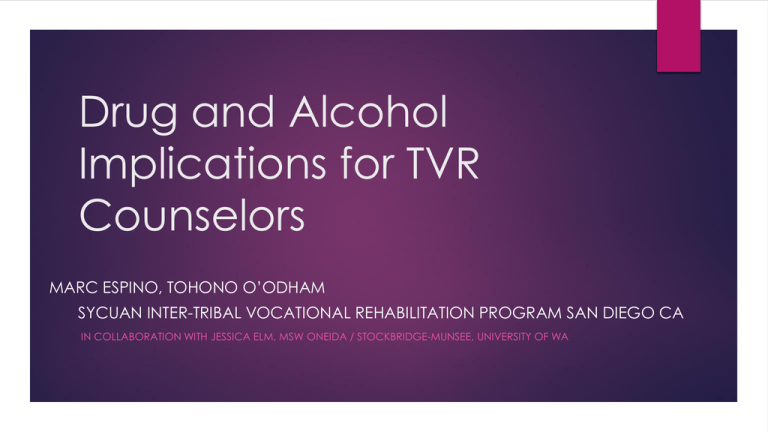
Drug and Alcohol Implications for TVR Counselors MARC ESPINO, TOHONO O’ODHAM SYCUAN INTER-TRIBAL VOCATIONAL REHABILITATION PROGRAM SAN DIEGO CA IN COLLABORATION WITH JESSICA ELM, MSW ONEIDA / STOCKBRIDGE-MUNSEE, UNIVERSITY OF WA Origins – Historically Traumatic Events Boarding School Period 1879-1935 + On and off-reservation boarding schools were developed after at Fort Marion Prison in Florida (1872-1875) where Native prisoners of war were held. 1879: “Kill the Indian, Save the Man” Policy Proposed forced removal at early age with no return until young adults 1909: 25 off-reservation boarding schools More than 100,000 Native children forced to attend these schools Attendance mandatory or parents would be imprisoned Relocation Era 1950’s – 1960’s U.S. government promised jobs and resources in an effort to encourage Native people to leave their Tribal lands and relocate to large metropolitan areas (Los Angeles, Bay Area, Seattle…) After arriving many were not provided what was promised. Some did not have the financial means to return to their Tribal homelands -either permanently or even for ceremony. Video Clip: We Shall Remain Origins –Trauma Response Trauma response Historically traumatic events Grief Sense of Loss Anger Coping Ceremony, Alcohol cultural practices and Substance Abuse Consequences: Life Course Problems Consequences: Risk Factors Hopelessness Impulsivity Behavioral Problems Unemployment Withdrawal School Problems Depression Poor Interpersonal Communication Limited Social Support Stigma Anxiety Family History Suicidal Behavior Domestic Violence Dual Diagnosis Geographic Isolation Child Abuse Personal Losses Suicide Clusters Slide borrowed from Rose Weahkee, PhD at the Indian Health Service Implications: Protective Factors Life Skills Hope Access Healthy Peer/Adult Modeling Sense of Humor Belonging Resources Available Interpersonal Competence Social Support Sense of Well-being Self-Esteem Strong Group Affiliation Family Support Good Health Language Cultural Identity Acceptance Help-Seeking Behavior Safety/Security Slide borrowed from Rose Weahkee, PhD at the Indian Health Service Protective Factors A 1999 study of risk and protective factors among AI/AN youth showed that “adding protective factors was equally or more effective than decreasing risk factors in terms of reducing suicidal risk.” Protective factors, similar to risk factors, are cumulative and interrelated. Enhancing the way in which people feel connected to community and family and strengthening their ability to cope with life’s challenges will help them achieve their full potential. Video Clip: White Bison.Org The Wellbriety Movement: Journey of Foregiveness Slide borrowed from Rose Weahkee, PhD at the Indian Health Service Implications: Living in Both Worlds History and Values Collective Communities Trauma, Stress -> Substance Use as a symptom Today’s Western Philosophy Economics Independence WORK Vocational Implications Eligibility Determination: Substance Use Disorders and diagnostic criteria; mild, moderate, severe (Addictive Disorders: Gambling Disorder) Comprehensive Evaluation: co-occurring disorders, history and barriers to employment AIVR as outpatient and aftercare services; length of sobriety IPE Development Disability Management: Counseling, cultural support groups/meetings, recovery coaches, ceremony Spiritual, Family, Cultural Interconnectedness Vocational Complications Work History: job loss, lack of positive references “Using behavior” and accountability Barriers: drug screening, background checks, transportation, esteem issues Transition to work phase: scheduling, decreased meetings and counseling, onset of work related stress/anxiety Lack of coping mechanisms: functional or dysfunctional coping skills Disconnection to cultural, family, and ceremonial supports Poor social support network Relapse potential Pathway from institutionalization: prison, jails, mental facilities, Implications: Psychological Consequences PTSD Generalized Anxiety Disorder Depression Guilt/Grief Attention problems Impulsive Control Issues Low Frustration Tolerance Lack of Time Perception Social Consequences Lack of Social Skills Loss of Activity of Daily Living (ADL) Skills: Self care activities; independent living skills, skills performed with others Immersion in Drug Culture Need for Positive Peer Supports Spiritual Consequences Hopelessness Despair Loss of Direction Need for Values Clarification Progression Cycle What would you do? Transparency in case management approach Personal perspective and personal beliefs Transparency in case management approach Medical Marijuana/Methadone Maintenance Relapse and recovery maintenance “Payment of residential treatment” Substance abuse counseling as employment outcome Case Studies/Song/Q & A


